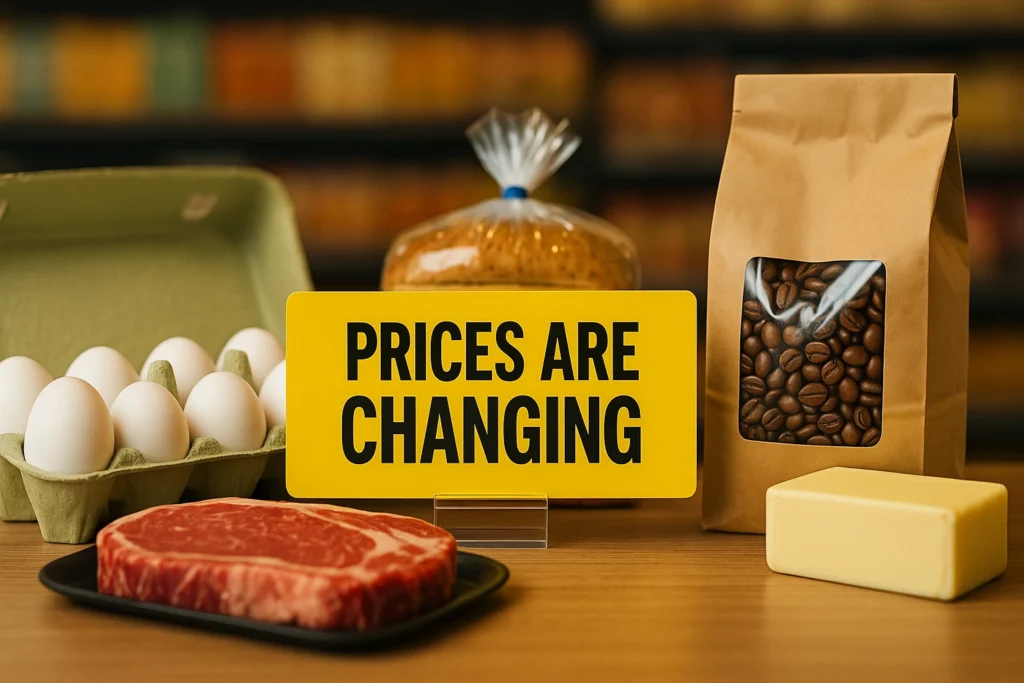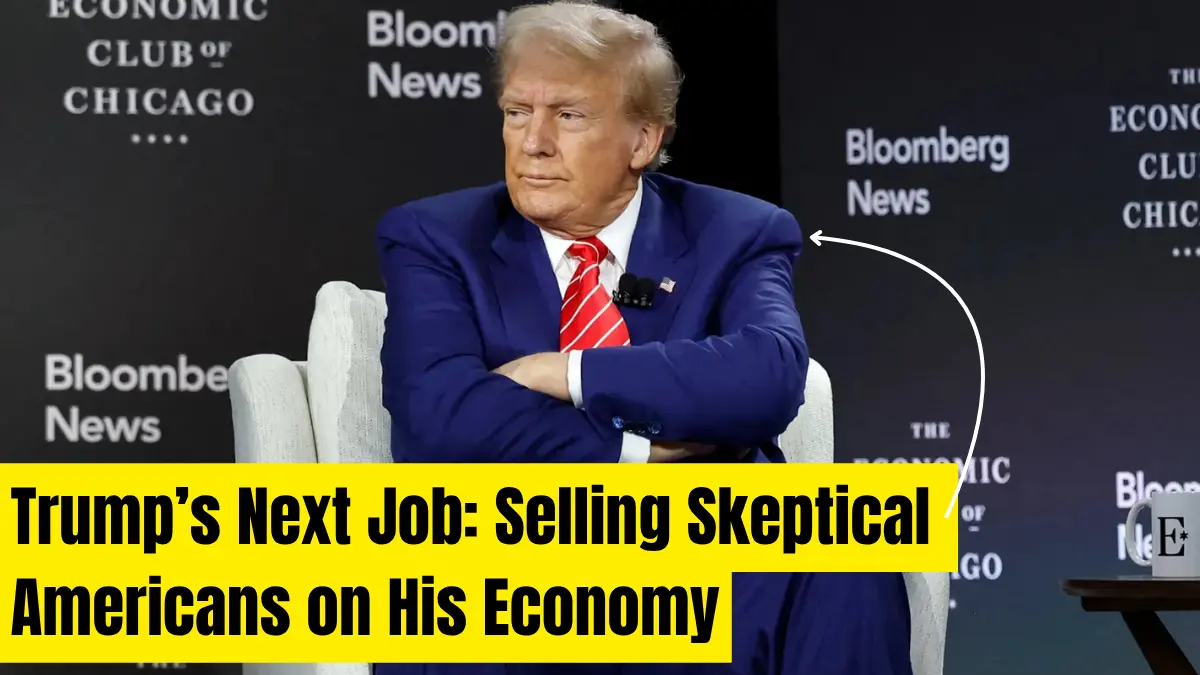As Trump touts record fundraising and economic recovery, many Americans remain unconvinced. Can he sell the story of a booming economy before the 2026 midterms?
Table of Contents
Trump’s Next Job: Selling Skeptical Americans on His Economy
Introduction: Trump Enters Sales Mode
With a booming stock market, rising wages, and low unemployment figures, the White House insists that America’s economy is thriving. But as President Donald Trump begins his second term, he faces an uphill task: convincing millions of skeptical Americans that they’re actually better off.
“All the naysayers and the doomsayers have been proven wrong,” said White House Communications Director Stephen Cheung. But public sentiment tells a different story.
Despite favorable economic indicators, many voters remain concerned about inflation, the lingering effects of supply chain disruptions, and ongoing trade tensions. As midterm elections approach, Trump’s next big challenge isn’t policy—it’s persuasion.
Fundraising Frenzy: Trump’s Financial Might
In a political landscape where money equals influence, Trump is coming out strong. According to the latest Federal Election Commission filings:
- Trump’s operation raised $236 million in the first half of 2025.
- This marks an unprecedented haul for a second-term president.
- Most of the funds are earmarked to support GOP House and Senate candidates.
This financial war chest could be decisive in battleground states and competitive districts. Analysts suggest that Trump will leverage this money to saturate media markets with messaging that frames him as the architect of an economic revival.
The Messaging War: Can Trump Win It?

For Trump, the midterms are more than just another election—they’re a referendum on his economic leadership. His administration is ramping up messaging across several fronts:
1. “It’s Morning in America” Redux
Expect Reagan-esque optimism in campaign ads: job creation, GDP growth, and high consumer confidence.
2. Countering Inflation Narratives
Despite inflation tapering off, many Americans still feel the pinch. Trump is expected to downplay the past and focus on the momentum of economic recovery.
3. Trade and Tariffs as a Strength
Trump is reframing tariffs as a patriotic economic defense rather than a consumer cost. It’s a tough sell—but one his team believes can work in rural and manufacturing-heavy areas.
The Redistricting Battle in Texas
In addition to messaging and fundraising, Trump is also actively reshaping the political map. One of his boldest moves? Urging Texas lawmakers to redraw congressional maps to favor Republicans.
What’s at Stake:
- Potential gains in GOP-friendly districts
- Legal challenges from Democrats
- A precedent for other Republican-controlled states
Democrats have called this an “unconstitutional power grab,” but Trump allies argue it’s simply “realigning representation with voter sentiment.”
What the Democrats Are Saying
While Trump fine-tunes his economic message, Democrats are trying to counter with a populist critique of Trump’s trade policy. Former Chicago Mayor Rahm Emanuel, who is rumored to be eyeing a 2028 presidential run, put it plainly:
“This is all about accepting that Donald Trump owns this economy.”
Emanuel believes the Democratic Party must frame Trump’s tariffs as hidden tax hikes, especially on middle-class families. However, the party remains divided on messaging, leadership, and how to reclaim working-class voters.

Voter Sentiment: The Gap Between Stats and Reality
Here’s the crux of the issue: positive economic statistics don’t always translate into voter confidence.
A recent Pew Research survey found that:
- 58% of Americans still feel “economically insecure.”
- Only 42% approve of Trump’s economic leadership, despite job growth.
- Younger voters and suburban women remain deeply skeptical.
This disconnect could prove problematic if the GOP fails to build an emotional narrative around the numbers.
The Midterm Math: Historical Trends vs. Trump’s Strategy
Traditionally, the party in power loses ground during midterms. But the 2026 elections may break that pattern due to:
- Weak Democratic polling
- No clear opposition leader
- An energized GOP base backed by major fundraising
Trump’s strategy seems simple: own the economy, shape the districts, flood the airwaves. But whether that will override historic midterm backlash remains uncertain.
Media Blitz: Trump’s All-Out Communication Effort
The Trump campaign has reportedly lined up:
- Over $50 million in ad buys for swing districts
- A nationwide “America is Winning” economic tour
- Scheduled appearances on Fox News, Newsmax, and even some independent podcasts
Expect an aggressive push across both traditional and digital platforms, tailored to demographics Trump underperformed with in 2024.
GOP Unity—or Fragility?
While the president raises record-breaking sums, internal tensions within the GOP still simmer:
- Libertarian-leaning Republicans remain wary of tariffs.
- Fiscal hawks criticize the national debt under Trump’s watch.
- Moderate Republicans fear overreach on redistricting could backfire.
Despite these concerns, few within the party are challenging Trump’s narrative directly—at least, not publicly.
Can Economic Optimism Be Engineered?
Trump is betting that a strong economy—at least on paper—can outweigh past controversies and polarizing rhetoric. But economic optimism isn’t just about GDP and stock prices. It’s about how people feel.
And right now, many Americans feel stuck. Wages are rising, but so are healthcare costs and rents. Jobs are plentiful, but job satisfaction remains low. The result? A hesitant electorate, unsure whether Trump’s version of reality reflects their own.
Related: How Tariffs Are Playing at the Grocery Store

The administration’s tariffs have affected industries from steel to produce. Grocery prices have stabilized in 2025, but some analysts warn of delayed inflation effects due to Trump’s ongoing trade war with China and now Brazil.
This could complicate his “everything is booming” narrative, particularly in regions where agricultural or retail prices remain volatile.
Conclusion: Trump’s Hardest Sell Yet?
For a president known for branding and showmanship, Trump’s newest campaign is perhaps his most personal—and most complex. He must convince Americans not just that things are improving, but that he’s the reason why.
Whether voters buy in will determine the fate of the GOP in 2026—and possibly the landscape of the 2028 presidential race.
FAQ: Trump’s Economic Messaging and the 2026 Midterms
Q: Why is Trump focused on selling the economy to Americans now?
A: With the 2026 midterms approaching, Trump is trying to shape voter sentiment around his economic leadership to avoid the typical losses suffered by incumbents during midterms.
Q: How much money has Trump raised for GOP candidates?
A: Over $236 million in the first six months of 2025, an unprecedented sum for a second-term president.
Q: What role does Texas redistricting play in this?
A: Trump is pushing for GOP-friendly maps in Texas to increase Republican seats in the House.
Q: What are Democrats doing in response?
A: They’re criticizing Trump’s tariffs as tax hikes on consumers and arguing that Trump’s economic record benefits the wealthy over working-class Americans.
Q: Do Americans believe the economy is booming?
A: Not entirely. Polls show a majority still feel economically insecure despite strong macroeconomic indicators.
